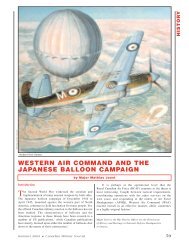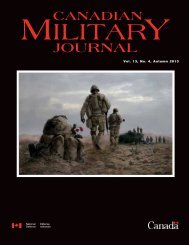MILITARY
JOURNAL CA - Revue militaire canadienne
JOURNAL CA - Revue militaire canadienne
- No tags were found...
You also want an ePaper? Increase the reach of your titles
YUMPU automatically turns print PDFs into web optimized ePapers that Google loves.
The first was a rather important departure from previous<br />
practice in that the AFC mandate directed that NSP be conducted<br />
“along post-graduate study lines” with an optional<br />
Royal Military College of Canada (RMCC)<br />
Master of Arts degree as part of the package.<br />
13 This mandate necessarily changed the<br />
flavour of the NSP when viewed against its<br />
antecedents. First, while AMSP and NSSP<br />
were certainly robust from a curriculum perspective,<br />
they had significantly less emphasis<br />
– as measured by writing opportunities<br />
– on individual critical thought. Where written<br />
work in these programmes represented<br />
only 30 percent (about 200 hours) of total<br />
contact time with instructors, that in NSP<br />
exclusive of the Masters represents about 80 percent (approximately<br />
470 hours). In a similar vein, instruction on the NSP is<br />
vastly different in methodology. AMSP and NSSP were delivered<br />
in the ‘traditional’ manner of most Professional Military<br />
Education (PME) facilities; participants were exposed to a<br />
variety of guest speakers and instructors with classroom continuity<br />
provided by a Senior Directing Staff (SDS) – normally a<br />
contracted retired general or flag officer. NSP methodology<br />
shattered this paradigmatic approach to PME, relying instead<br />
upon a blend of doctorate-level teaching teams, which provide<br />
academic continuity through each of seven integrated core<br />
courses and SDS (refashioned as Senior Mentors in the programme’s<br />
second serial), who have been entrusted with relating<br />
these intellectually rigorous studies to professional practice.<br />
And while emphasis upon external speakers has been<br />
diminished as a result of the new<br />
teaching concept, guests still play a<br />
valuable role in providing outside<br />
viewpoints to NSP participants at<br />
selected points in the curriculum.<br />
In short, the new tripartite methodology<br />
purposefully strings together<br />
the various instructional themes of<br />
the programme into a more continuous<br />
whole – one that holistically<br />
links theory and practice in admirable<br />
fashion.<br />
The second key factor in this<br />
evolutionary process was an<br />
explicit adjustment to the structure<br />
of the NSP nominal roll. This<br />
structure was evident in the AFC<br />
guidance, which read:<br />
“International military officers,<br />
DND executives and civilians from<br />
other government departments and<br />
agencies may also participate in<br />
the NSP” (emphasis added). 14 As previously discussed, civilian<br />
participation on AMSP was non-existent, and such involvement<br />
on NSSP was limited to no more than one-tenth of the<br />
roll, and composed only of DND executives. NSP has broken<br />
new ground in this respect. In the pilot serial, civilian executive<br />
membership ballooned to 25 percent, and included participants<br />
from the Department of Foreign Affairs and<br />
International Trade, Public Safety Canada, the Department of<br />
“Explicit in the AFC<br />
direction were two key<br />
points which clearly<br />
differentiated the NSP<br />
from its predecessors:<br />
its method of study,<br />
and its nominal roll.”<br />
Justice, and Public Works and Government Services Canada,<br />
in addition to one member from the private sector, and three<br />
members from DND. The aggressive campaign for a comprehensive<br />
nominal roll continued into followon<br />
serials. As the programme hit steady<br />
state in its third iteration, it boasted a civilian<br />
contingent of one-third drawn from eight<br />
different government departments/agencies<br />
and the private sector. This wide-ranging<br />
student base has important, beneficial<br />
impact upon all participants – military to<br />
civilian, Canadian to international; it is perhaps<br />
the value of this dynamic that accounts<br />
for the 42 percent hike in civilian participation,<br />
and the corresponding jump of 33 percent<br />
in outside organizations represented between the first and<br />
third serials.<br />
In short, the NSP represents a ground-breaking, holistic<br />
approach to the problems of today, and where AMSP and<br />
NSSP were appropriate in their time, NSP is appropriate now.<br />
Through careful balancing of teaching method and programme<br />
composition, the NSP seeks to bridge the gaps among<br />
governmental agencies, and between the public and private<br />
sectors. And it does so through a well-considered blend of<br />
critical thinking, fostered by academic study and professional<br />
growth cultivated by retired practitioners. This leads to the<br />
most important question of all; namely, what does the NSP<br />
graduate provide to both the Canadian Forces and the<br />
Government of Canada?<br />
Course NSP 01 ‘gets an earful’ from a very experienced soldier, Brigadier-General David Fraser.<br />
The Result<br />
The NSP graduate is a unique individual capable of fulfilling<br />
four important roles within the broader national<br />
security apparatus of the state. Participants leave the programme<br />
with the requisite understanding to serve as a Leader<br />
of the Institution, to act as an Implementer of National<br />
Security Policy, to perform as a Designer of National<br />
DND photo by Sergeant Charles Barber, J6 Imagery, CFC<br />
<strong>MILITARY</strong> EDUCATION AND TRAINING<br />
Vol. 12, No. 4, Autumn 2012 • Canadian Military Journal 21





